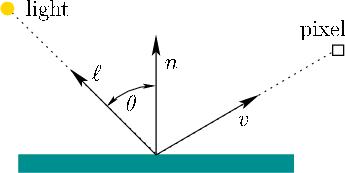
Next: Blinn-Phong shading Up: 7.1 Ray Tracing and Previous: Ray casting Contents Index
 |
Now consider lighting each pixel and recall the basic behavior of light from Section 4.1. The virtual world simulates the real-world physics, which includes the spectral power distribution and spectral reflection function. Suppose that a point-sized light source is placed in the virtual world. Using the trichromatic theory from Section 6.3, its spectral power distribution is sufficiently represented by R, G, and B values. If the viewing ray hits the surface as shown in Figure 7.2, then how should the object appear? Assumptions about the spectral reflection function are taken into account by a shading model. The simplest case is Lambertian shading, for which the angle that the viewing ray strikes the surface is independent of the resulting pixel R, G, B values. This corresponds to the case of diffuse reflection, which is suitable for a ``rough'' surface (recall Figure 4.4). All that matters is the angle that the surface makes with respect to the light source.
Let ![]() be the outward surface normal and let
be the outward surface normal and let ![]() be a vector from the surface intersection point to the light source. Assume both
be a vector from the surface intersection point to the light source. Assume both ![]() and
and ![]() are unit vectors, and let
are unit vectors, and let ![]() denote the angle between them. The dot product
denote the angle between them. The dot product
![]() yields the amount of attenuation (between 0 and
yields the amount of attenuation (between 0 and ![]() ) due to the tilting of the surface relative to the light source. Think about how the effective area of the triangle is reduced due to its tilt. A pixel under the Lambertian shading model is illuminated as
) due to the tilting of the surface relative to the light source. Think about how the effective area of the triangle is reduced due to its tilt. A pixel under the Lambertian shading model is illuminated as
Using vector notation, (7.1) can be compressed into
Steven M LaValle 2020-11-11